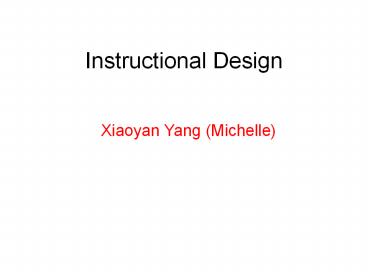Instructional Design - PowerPoint PPT Presentation
1 / 12
Title:
Instructional Design
Description:
Learning theory includes behaviorism, ... Seels&Glasgow Model etc. Instructional Design There are many different instructional design models from which to choose. – PowerPoint PPT presentation
Number of Views:167
Avg rating:3.0/5.0
Title: Instructional Design
1
Instructional Design
- Xiaoyan Yang (Michelle)
2
Instructional DesignIt is not a learning
theory, but a systematic process. It is based on
the characteristics of curriculum standards and
teaching objects, and teaching various elements
of an orderly arrangement will determine the
ideas and plans for appropriate teaching programs.
3
Instructional Design TheoryLearning
TheoryInstructional Design ModelInstructional
Design is a systematic process for the creation
of educational resources, not a learning theory.
Learning theory includes behaviorism,
cognitivism and constructivism.Instructional
Design Model includes ADDIE, DickCarey Model,
SeelsGlasgow Model etc.
4
Instructional Design There are many
different instructional design models from which
to choose. Many of these models have common
features suchNeeds assessments, development of
objectives and an iterative
5
Instructional Design Dick and Carey
6
Instructional Design ADDIE
7
Analysis A systematic process of learning/
deciding WHO, WHAT and HOW
8
Design Key aspects are delivery decisions,
templates, interaction planning, paper models
and/ or storyboards, navigation and testing
9
Development Developing performance measures
should always take into consideration the
learners Development of performance objectives
and development of its assessment are important
10
Implementation Beta testing, and revise some
bugs
11
Evaluation Judge quality of process you use
12
Why Use Instructional DesignThe concept of a
system approach is based on obtaining an overall
view of the learning process. It is characterized
by an orderly process for gathering and analyzing
collective and individual performance
requirements, and the ability to respond to
identified learning and training needs. The
application of a systems approach insures that
learning programs and the required support
materials are continually developed in an
effective and efficient manner to match the
variety of needs in a rapidly changing
environment. (Branson, 1975)































